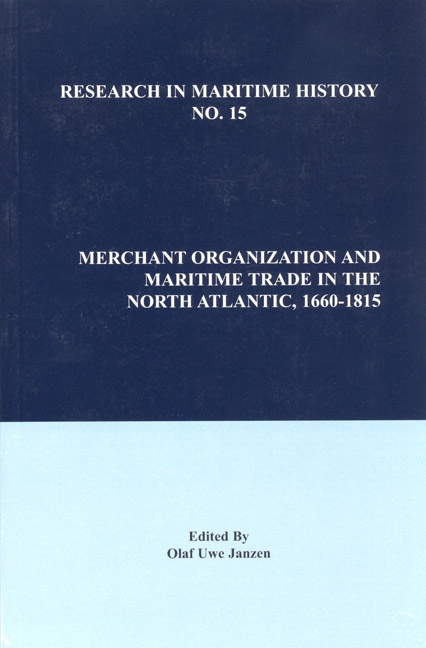Book contents
- Frontmatter
- Contents
- Contributors
- Preface
- CONTRIBUTIONS
- “Introduction”
- “The Gaigneur Clan in the Seventeenth-Century Canada Trade”
- “Credit, Risk and Reputation in Late Seventeenth- Century Colonial Trade”
- “The Huguenot Diaspora and the Development of the Atlantic Economy: Huguenots and the Growth of the South Carolina Economy, 1680-1775”
- “Breaching the Mercantile Barriers of the Dutch Colonial Empire: North American Trade with Surinam during the Eighteenth Century”
- “A Scottish Venture in the Newfoundland Fish Trade, 1726-1727”
- “The Consolidation of Bilbao as a Trade Centre in the Second Half of the Seventeenth Century”
- “Cutting Out The Middleman? American Trade In Northern Europe, 1783-1815”
- “A Vital Link in Wartime: The Organization of a Trade and Shipping Network Between the United States and Bordeaux, 1793-1815”
- “The Challenge of War on Maritime Trade in the North Atlantic: The Case of the British Trade to Iceland During the Napoleonic Wars”
“The Challenge of War on Maritime Trade in the North Atlantic: The Case of the British Trade to Iceland During the Napoleonic Wars”
from CONTRIBUTIONS
- Frontmatter
- Contents
- Contributors
- Preface
- CONTRIBUTIONS
- “Introduction”
- “The Gaigneur Clan in the Seventeenth-Century Canada Trade”
- “Credit, Risk and Reputation in Late Seventeenth- Century Colonial Trade”
- “The Huguenot Diaspora and the Development of the Atlantic Economy: Huguenots and the Growth of the South Carolina Economy, 1680-1775”
- “Breaching the Mercantile Barriers of the Dutch Colonial Empire: North American Trade with Surinam during the Eighteenth Century”
- “A Scottish Venture in the Newfoundland Fish Trade, 1726-1727”
- “The Consolidation of Bilbao as a Trade Centre in the Second Half of the Seventeenth Century”
- “Cutting Out The Middleman? American Trade In Northern Europe, 1783-1815”
- “A Vital Link in Wartime: The Organization of a Trade and Shipping Network Between the United States and Bordeaux, 1793-1815”
- “The Challenge of War on Maritime Trade in the North Atlantic: The Case of the British Trade to Iceland During the Napoleonic Wars”
Summary
This paper discusses an instance when war compelled merchants to venture into trades that were new to them. Specifically, it examines the introduction during the Napoleonic Wars of British trade to Iceland, a dependency of Denmark, one of England's enemies. War between Denmark and Great Britain broke out officially in November 1807 and continued until a peace treaty was finally concluded in Kiel in January 1814. Why did British merchants become interested in trading with Iceland and how was the trade conducted? This paper will attempt to answer these questions.
Iceland in 1800
At the beginning of the nineteenth century Iceland had a population of only about 47,000. Its society was made up of a small landowning class and a large tenant peasantry. Most Icelanders lived on isolated farms and were engaged primarily in animal husbandry (mainly sheep farming) with fishing as a subsidiary occupation. There were no villages, only trading stations dotted along the coast. Reykjavik, the principal mercantile station and centre of administration, had only three hundred inhabitants. The island lacked both fortifications and a defence force.
In 1788 the “Free Trade Charter” brought two centuries of mercantilist monopoly trade to an end. Henceforth only independent merchants, subjects of the Dano-Norwegian kingdom — with the exception of the Faroes and Greenland but including native Icelanders — would be permitted to participate in the Iceland trade. The basic principle of the new trade system was to exclude foreign merchants from trading to Iceland and strictly to forbid Icelanders from having any direct commercial dealings with “foreigners.” Almost all of the merchants active in Iceland during this period were Danes resident in Denmark for the better part of the year. In the spring they and their ships would arrive in Iceland; they would trade during the summer season (the handet) and return to their homeland in late summer or autumn. Only a handful of native Icelanders were engaged in trade.
The Iceland trade was a barter trade; little money was in circulation. The principal exports were: fish, including both stockfish (dried cod) and klipfish (dried salted cod); fish liver oil (train-oil); wool and woollen products of various kinds, such as stockings and mittens; tallow; salted mutton; eiderdown; feathers; the skins of sheep, fox, and swans; and sulphur. British merchants also sought such items as reindeer antlers, minerals and horses suitable as pit ponies.
- Type
- Chapter
- Information
- Publisher: Liverpool University PressPrint publication year: 2017

